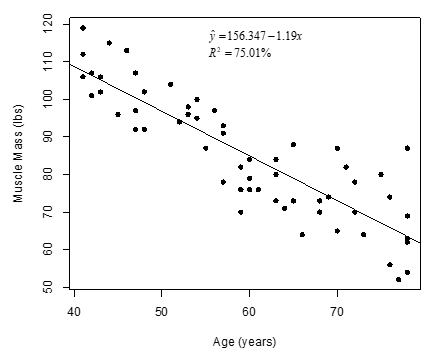Multiple Choice
It is commonly expected that as a person ages, their muscle mass decreases. To further examine this relationship in women, a nutritionist randomly selected 60 female patients from her clinic, 15 women from each 10-year age group beginning with age 40 and ending with age 80. For each patient, her age and current muscle mass was recorded. A scatterplot, least squares regression line, and coefficient of determination are as follows. 
-The p-value for these data was less than 0.0001. Write a conclusion of the test in the context of the study.
A) We have strong evidence that an increase in age causes a decrease in muscle mass.
B) We have strong evidence that age is negatively correlated with muscle mass.
C) We do not have strong evidence that an increase in age causes a decrease in muscle mass.
D) We do not have strong evidence that age is negatively correlated with muscle mass.
Correct Answer:

Verified
Correct Answer:
Verified
Q6: The correlation coefficient is the proportion of
Q7: Are people with bigger brains more intelligent?
Q8: It is commonly expected that as a
Q9: Data from gapminder.org on 184 countries was
Q10: Data from gapminder.org on 184 countries was
Q12: Data from gapminder.org on 184 countries was
Q13: Data from the World Bank for 25
Q14: The following scatterplot displays the finish time
Q15: It is commonly expected that as a
Q16: A student in an AP Statistics class